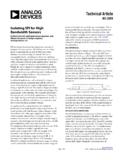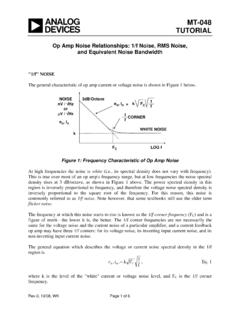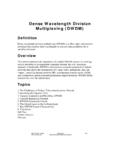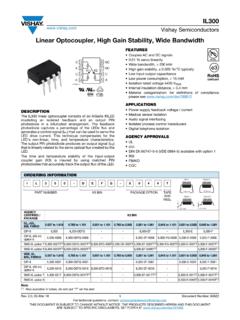Transcription of VoIP Bandwidth Considerations - …
1 voip Bandwidth Considerations - design decisions When calculating the Bandwidth requirements for a voip implementation the two main protocols are: a signalling protocol such as SIP, , SCCP, IAX or MGCP for call set up, and control; and a protocol to carry the voice audio stream. The Real-Time Transport Protocol (RTP) is normally used to carry the voice audio stream. An IETF standard RTP will work with any signalling protocol. Factors effecting the quality of a voip call Reliability (needs to be less than 1% loss) Delay (<250ms to prevent speech collisions , <150ms ideal) ITU recommendation calls for <150ms domestic, <200ms internationally and <400ms via satellite for the one way delay Delay Variation = Jitter (<10ms) Bandwidth (prioritized queuing & call admission control) LFI (link fragmentation and interleave) required on slow data/voice links A voip source can be configured to sample audio and produce a voice packet every 10, 20, 30 or 40ms, depending on the vendor's implementation.
2 The packet of digitized speech can be uncompressed, compressed and/or encrypted, changing the overhead and the final size of the packet carried over the network. A user will detect voice break-up and poor quality if there is too much delay, loss or distortion. The choice of packet size is made based upon delay through the network, Bandwidth available and packet loss within the network. A short packet creation delay, enables more network delay to be tolerated. Shorter packets cause less of a problem if the packet is lost, but shorter packets require more Bandwidth to to the increased overhead. Long packets that contain more voice audio reduce the Bandwidth requirements but produce a longer delay and are therefore more noticeable if they are lost somewhere in the network. Most vendors opt for a middle of the road packet size of 20 or 30ms. The CODEC (COder/DECoder) is the element used to digitise the voice audio and converts it back into an analogue audio stream.
3 The CODEC is the analogue-to-digital-to-analogue converter in the IP Phone, IP PBX, softphone, gateway different CODECs perform at differing bit sample rates and also perform compression and decompression. Most vendors support one or more of the following ITU standards : often the default standard for IP PBX, IP phones and ATA vendors, as well as for the digital PSTN and trunks. This standard digitizes voice into 64 Kbps before encapsulation with no compression is supported by many vendors for compressed voice operating at 8 Kbps, 8 to 1 compression. With quality just below that of , although hard to detect the difference. There is a licensing fee associated with every active call stream in use. Ideal CODEC for WAN and low Bandwidth circuits. To be avoided on links going through tandem encoding such as to GSM networks. was once the recommended compression standard.
4 It operates at Kbps and Kbps. Although this standard further reduces Bandwidth consumption, voice is noticeably poorer than with , so it is not very popular for voip . operates at 64 Kbps, but offers high-fidelity speech. Whereas the three previously described standards deliver an analogue sound range of kHz, delivers 7 kHz. This version of digitized speech has been announced by several vendors and will become common in the future. The quality of a voice call is defined by the Mean Opinion Score (MOS) 0 to 5. A score of to is considered to be toll quality. Voice compression affects the MOS as the sampling rate drops so does the MOS. An MOS below will usually produce complaints from the users. Cell phone calls average about to for the MOS. Standard Speed MOSS ampling delay per phone 64 ms 64 Kbps 8 Kbps 10 ms 8 Kbps 10ms GSM 14 Kbps 20ms 16 Kbps 30 ms Packet Format for the digitised voice audio stream It is useful to remember the OSI layered construction of the data through the network.
5 Each layer in the OSI adding the headers, addressing and port information to The RTP header field contains version, identifiers, M bit (marker for playout burst), time stamp and sequence numbers (for packet loss detection) for the content of the following voice sample. A payload type field within RTP defines the compression technique used in the sample and is used by SDP to identify the CODEC. In practice the standard payload type codes are not used because of variations in how the vendors have implemented their CODECs and a mapping of RTP payload type to configured CODEC is found in most voip IP PBX systems. The RTP packet format for voip is shown below with example CODEC sample IP header UDP header RTP header CODEC sample Xms CODEC sample Xms 20 Bytes 8 Bytes 12 Bytes 10 Bytes 10 Bytes The RTP can be encapsulated using Ethernet, frame relay, ATM, PPP with the digitized CODEC sample, RTP, UDP and IP headers remaining the same through the network.
6 Each of the above packets will contain a snap-shot of the voice audio with a packet rate of 50 packets per second for 20ms and packets per second for 30ms voice samples. Depending upon the layer-2 protocol, the header and trailer overheads can make or break the voip service consuming 20% to 80% of the Bandwidth . As shown in the RTP packet layout, there can be at least 40 bytes of overhead before encapsulation into yet another 18 bytes of overhead for Ethernet frames or 6 to 8 bytes for Frame Relay and/or PPP. As the size of the voice field gets larger with longer packets, the percentage of overhead decreases -- therefore the needed Bandwidth decreases. In other words, bigger packets are more efficient than smaller packets. Header compression Cisco s header compression technique is now the industry standard called RTP header compression. This technique actually compresses the RTP, UDP and IP headers and significantly reduces the RTP, UDP and IP overhead from 40 bytes to between 4 and 6 bytes.
7 The Bandwidth consumption for compressed voice packets can be reduced by nearly 60%. This technique has less value for large uncompressed voice packets. Calculating Bandwidth consumption for voip As seen above, the Bandwidth required for voip will depend on several factors: the compression technology CODEC, packet overhead, network protocol used and whether silence suppression is used. Also several factors effect the Bandwidth , delay, jitter and losses within a network: Bandwidth available, queuing strategy, QoS, reliability and resilience. Not all of these factors are under the control of the enterprise. In the real world, a compromise often has to be made between cost and Bandwidth . It is not always possible or cost effective to just add Bandwidth to implement voip , QoS is not always available on the lowest cost Teleco circuits and all the Telco options of DDI, PRI, BRI, SIP trunks, leased circuits and DSL with the required supporting hardware have to be evaluated.
8 The enterprise will often have to accept that during times of busy voice activity the data network response will be slightly slower, if there are not enough funds to provide the luxury of ample Bandwidth . For example The choice of CODEC @ 64kbps (8000 Bytes per sec) or @ 8kbps (1000 Bytes per sec) offers MOS of or which most people can not differentiate, but will suffer if tandem encoding has to be used to reach a GSM network and drops the MOS to In noisy environments a higher bit rate is also desirable as the noise levels are higher with the more complex CODECs. In short; Choose a higher bit rate CODEC for noisy environments Do not use low bit rate CODECS for tandem encoding routes Use single CODEC frame per packet when using low bit rate CODECs on poor networks with suboptimal QoS Use low bit rate CODECs were possible on WAN routes and on conferencing scenarios There are cost implications a CODEC will often cost an additional $10 licensing fee per concurrent one-way audio stream.
9 Some of the lowest cost hardware does not support higher bit rate CODECs. That said, the Bandwidth requirements for a one-way voice stream using , with RTP compression and a 20ms sample is approximately 32kbps. Using , with RTP compression and a 40ms sample is approximately 22kbps. with RTP compression and 20ms sample is 88kbps. with RTP compression and 40ms sample is The choice of packet size, voice compression and header compression make it difficult to determine the required voip Bandwidth . Bandwidth requirements reduce with compression, vs. Bandwidth requirements reduce when longer packets are used, thereby reducing overhead, but packets more prone to audio drop during loss Even though the voice compression is an 8 to 1 ratio, the Bandwidth reduction is about 3 or 4 to 1. The overhead negates some of the voice compression Bandwidth savings. Compressing the RTP, UDP and IP headers (cRTP) is most valuable when the packet also carries compressed voice.
10 If silence suppression/voice activity detection is used, the Bandwidth consumption may drop 50% -- to 8 Kbps total per voip call. Bandwidth allocation for call setup and RTCP is shown in RFC3556 to require about 5% of the RTP session Bandwidth . For call using 88kbps the RTCP would require 4kbps, for G729 call using 22kbps the RTCP would require about 1kbps. Comparison of circuits available form the Telco .. There are a bewildering amount of circuits and managed options available from the Telcos, here is just a few. Most enterprises allocate about 33% of their connected telephones the facilities for concurrent a company with 99 extensions would be expected to have the capacity to have 33 concurrent voice calls at any time. E1 European lease line circuit of used to carry 32 x 64kbps T1 US leased line circuit of Mbps used to carry 24 x 64kbps channels Frame Relay provides access circuits to Telcos frame and cell networks or can be used as private enterprise networks ATM as above.











